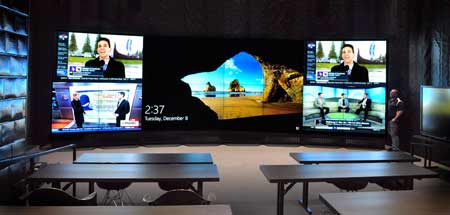
What Are Some Of The Leading Video Wall Solutions And Manufacturers?
What are some of the most trusted names in video wall solutions?
Video walls, perhaps more than any other A/V solution, can do some amazing things. They are the ideal solution when maximum visual impact is needed, so they are frequently used to capture attention. There is also a novelty factor involved, as people don’t encounter video walls in their day to day lives, for the most part. Companies and organizations, then, have a plethora of options in building their video wall and designing interesting layouts. But before that can happen, the right video wall manufacturer and video wall product must be selected. There are a few standout manufacturers producing top notch video walls. These brands can be trusted with quality products and innovative solutions, so they are the go-to options for A/V integrators. They include Samsung, Planar and Christie Digital Systems.What video wall solutions do Samsung, Planar and Christie have to offer?
Although each brand has worthy video wall products, there isn’t much overlap in their product catalogues. Video walls are extremely flexible systems, as the displays themselves can be modified with innovative engineering, and then designed in a way that is wholly unique. This gives buyers a lot of options in determining what video wall will work best for their application. Here are what some of those solutions look like:1. Samsung’s product offerings – Between the three, Samsung is likely the most recognizable brand. As such, its solutions are aimed at the mainstream, designed to work in a variety of settings and with a variety of applications. Samsung is a respected name in many fields, making Samsung a safe, reliable option for companies that value reliability above all else.
Samsung offers a deep catalogue of video wall solutions, and among them, the UDE-P and UDE-S series are standouts. The UDE-P and UDE-S share many features, but the UDE-S is a specialized product intended for use in broadcast environments. It is designed with a shorter color temperature range, which means that when placed under intense studio lights, it will not lose its ability to produce accurate output color. With more accurate color, the UDE-S series can faithfully produce images and video from a studio environment and be presented to viewers sitting in their homes.
The UDE-P series is built with a standard color temperature range but is precisely color calibrated before leaving Samsung’s factories. Samsung has this down pat, so its video walls offer some of the best color accuracy on the market. UDE-P displays will not darken at the edges, either, so the image is even across the entire video wall. Also, the UDE-P series is built with thin bezels and with greater contrast ratios, so they can be easily seen and read from a distance. Finally, the UDE-P series is an all-in-one solution, which means it comes with an onboard media player. This allows users to quickly utilize onboard content management software to create a layout, configure it and program video wall usage.
Samsung also manufactures video walls intended for use outdoors, with protective housing and an embedded power box. These displays are an excellent option for areas with high foot traffic.
2. Planar’s product offerings – Compared to Samsung, Planar and Christie offer solutions that can be considered more niche. That’s not to say they don’t provide standard video wall solutions, because they do, but if something a bit more specialized is needed, Planar and Christie will have it.
Planar is wholly devoted to the digital display market, and its video wall technology comes in many forms. The Leyard DirectLight deserves much of the attention, and is a favorite among integrators. The Leyard DirectLight is a seamless video wall solution, available in a variety of pixel pitches, from 2.5 mm to .7 mm. As such, it can be adapted for any viewing distance, and used to create some finely detailed images. What is most interesting about the Leyard DirectLight is how it is mounted. Planar has developed a form of display mounting that eliminates the need for bezels, and ensures the displays work together in concert.
The Leyard DirectLight uses the Leyard EasyAlign mounting technology, so there is no bezel and the displays only require 4 in. of depth from the wall. The video wall snaps together with positive locking and can be installed with forward tilt while maintaining 90-degree corner installation capabilities. Power, heat and service points are located in a room behind the video wall, keeping everything away from the video wall itself.
3. Christie’s product offerings – Again, it would be wrong to label Christie as a niche-only video wall provider, as the company develops an impressive variety of video wall solutions.
Christie’s MicroTiles are perhaps the most inventive approach to video walls available, and they could very well be the future of the technology. MicroTiles are like video wall building blocks, designed to connect to each other in a variety of patterns. Once connected, the MicroTiles automatically detect each other and match their color and brightness to neighboring displays. The MicroTiles can be arranged in designs that would be difficult to pull off with other video walls, like staircases, concave walls and arches. The bezel between every MicroTile is less than 1 mm thick, so seamless images are possible.
Maintenance is a snap, too, because the MicroTiles can be accessed from the front and hot-swapped on the fly. This allows technicians to do what they need to do without bringing the entire video wall down.
Samsung, Christie and Planar are considered leaders in video wall technology, and for good reason. Their video wall solutions can be configured for any organization, and built to get attention, wherever they go.

